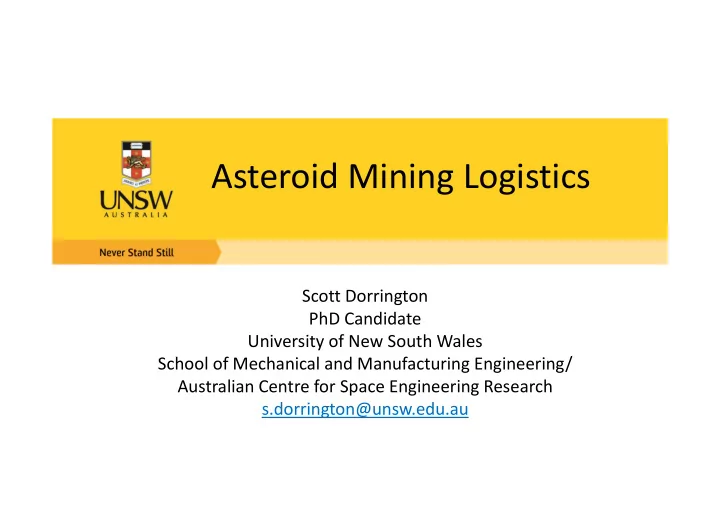

Asteroid Mining Logistics Scott Dorrington PhD Candidate University of New South Wales School of Mechanical and Manufacturing Engineering/ Australian Centre for Space Engineering Research s.dorrington@unsw.edu.au
Basic Logistics Components 5. Delivery Depot/Customer • 3. Mining Ops Refuel for next trip • 4. Asteroid ‐ Earth Stay ‐ time • Revenue +$R • Heliocentric transfer Resource Mass • • LD, AD, TOF, Δ V • 2. Earth ‐ Asteroid Heliocentric transfer • LD, AD, TOF, Δ V • 1. Launch To parking orbit or • departure hyperbola Capital investment ‐ $C 0 •
Basic Logistics Components 5. Delivery Depot/Customer • 3. Mining Ops Refuel for next trip • 4. Asteroid ‐ Earth Stay ‐ time • Revenue +$R • Heliocentric transfer Resource Mass • • LD, AD, TOF, Δ V • 2. Earth ‐ Asteroid Heliocentric transfer • LD, AD, TOF, Δ V • 1. Launch To parking orbit or • departure hyperbola Capital investment ‐ $C 0 •
P1. System Design Q: How much mass can you extract in a single trip? Duration of stay ‐ time (from trajectories) • Mining rate • Design optimization problem & Mine optimization problem Parameterize mining rate using 4 components: • 1. Physical & chemical properties of the asteroid 2. Design of spacecraft & mining equipment 3. Operations conducted on unit blocks of ore 4. Shape of the mine Trade space optimization • – e.g. min. Total mass Mine Parameters IAC D4.5.2 Mining Requirements for Asteroid Ore Extraction
P2. Supply Chain Network Q: How much of this mass can you deliver to customers? Spacecraft will use fuel to deliver the resources to customers • Reusability – extract fuel for next trip before selling • Sellable mass • Location ‐ routing problem Orbital supply chain network • Location of orbital nodes (parking orbits, customers, depot) • Routes between nodes ( Δ V of transfers ) • Vehicles – transport spacecraft, mining spacecraft • Select location of orbital nodes, and route of spacecraft to • maximize total sellable mass
Optimization problem: Candidate locations: Candidate routes: A location ‐ routing problem for the design of an asteroid mining supply chain network [Dorrington & Olsen, 2017] (under review, Acta Astronautica )
P3. Multi ‐ trip trajectory optimization Q: How much profit can you make from a specific asteroid? LD (Ast ‐ Earth) Total NPV over multiple trips • NPV = ‐ $C 0 + Σ R(1+i) -t AD (Earth ‐ Ast) AD (Ast ‐ Earth) Flight Itinerary: Ast ‐ Earth Earth ‐ Ast Cash Flow LD (Earth ‐ Ast) Trip 0: ‐ (LD 0, AD 0 ) ‐ $C 0 Trip 1: (LD 1, AD 1 ) (LD 1, AD 1 ) +$R 1 Trip 2: (LD 2, AD 2 ) (LD 2, AD 2 ) +$R 2 Trip T: (LD T, AD T ) (LD T, AD T ) +$R T
Available Trajectories – Lambert solver ‐ > Porkchop plots – local optima Time ‐ Expanded Network – combinations of trajectories – constraints on stay ‐ time, wait ‐ time Shortest path problem – find path that maximizes NPV – NPV of each path non ‐ linear fn – path enumeration using DFS – adapt shortest path algorithms Use to rank asteroids based on profit, rather than single ‐ trip Δ V
P4. Prospecting Approach Q: What is the best prospecting approach? Flyby mission Flyby mission • Sampling mission – shape and mass measurements – limited by instruments, trajectory Sampling mission (orbiter/lander) • – surface mapping from orbit * Image credit: ESA – sampling can confirm presence of resources Each mission increases certainty of presence of • ore, at the cost of extra capital cost Cost ‐ Risk analysis
Decision Tree Decisions • – send/don’t send missions Outcomes • – ore found/no ore found – probabilities of each occurring Consequences • – total cost of each approach Expectation value • – select prospecting approach that maximizes expected NPV p = probability of outcome q = 1 – p = complement
Conclusion Formulate logistics problems to optimize the design of an asteroid mining industry Problems: Q1: How much mass can you extract in a single trip? Design optimization problem & Mine optimization problem • Q2: How much of this mass can you delivered to customers? Location-routing problem • Q3: How much profit can you make from a specific asteroid? Shortest path problem • Q4: What is the best prospecting approach? Cost ‐ Risk analysis •
Questions? Scott Dorrington PhD Candidate University of New South Wales School of Mechanical and Manufacturing Engineering/ Australian Centre for Space Engineering Research s.dorrington@unsw.edu.au
Recommend
More recommend